Old Town Warsaw
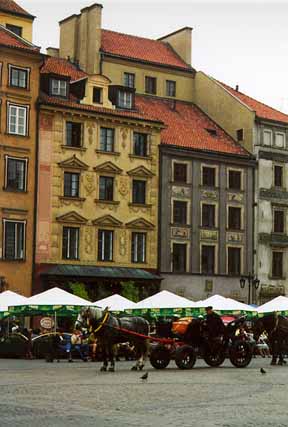
Reconstructed buildings
in Old Town Warsaw
Warsaw has two historic districts, called
Old Town and New Town. They are adjacent to each other and the
newer section is almost as old as the Old Town. The Old Town,
called Stare Miasto in Polish, was completely destroyed in World
War II but, like Nürnberg, some of it has been rebuilt to
look like the original. Without a guide to tell you these things,
one would never guess that the market square in Old Town Warsaw
is a complete reconstruction. This market square, known as a
Rynek in Polish, was thriving way back in the 13th century.
Until 1817, the Rynek or town square
of Old Town Warsaw had a town hall in the middle of it, but it
was torn down to make more room for the merchants who traded
there. As Warsaw grew, the wealthy people abandoned the mansions
on the square and they were subdivided into apartments. One of
the mansions now has the Historical Museum of Warsaw and another
has the Adam Mickiewicz Literary Museum.
Warsaw is bisected by the River Vistula
and it is the left bank that is of interest to visitors. On the
other side of the river is a residential area which is a depressing
sight. The whole city of Warsaw is built on completely level
terrain, except that Old Town is a few feet lower, so it is like
stepping down into another room in a split level house when you
enter the historic district. After the city of Warsaw was destroyed
in World War II, the main part of the city was rebuilt with modern
buildings constructed on top of the rubble. Only the Old Town
was cleared and the buildings reconstructed, which accounts for
the split level effect.
Regarding the destruction of Warsaw,
Dariusz Tarkowski wrote the following in an e-mail letter to
me in 2005:
It is estimated that during
World War II, 85% of Warsaw's left bank buildings were destroyed.
35% were destroyed in 1944 with dynamite, flamethrowers and bombs,
building by building, in retaliatory actions by the German military
for the failed Warsaw Uprising of 1944. When the uprising failed,
all the civilian population was deported and a planned and
systematic operation of destruction was carried out. Historical
buildings, like the Royal Castle, were specifically targeted
during this operation. Further 25% of the buildings were destroyed
in the course of the fights during the Warsaw Uprising of 1944
itself. A certain number was destroyed during the Warsaw Ghetto
Uprising of 1943 and only the rest was destroyed during the war
in September 1939 and the bombing campaign of that time.
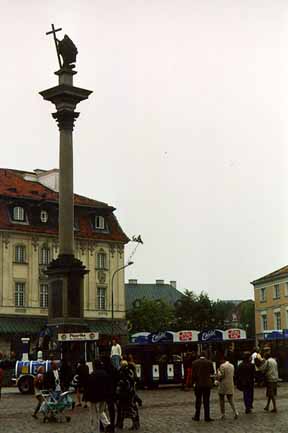 Statue of King Zygmunt
Waza at entrance to Old Town
Statue of King Zygmunt
Waza at entrance to Old Town
The entrance to Old Town is marked by
a 72-foot high Corinthian column on top of which is a bronze
statue of King Zygmunt Waza, the monarch who was responsible
for moving the capital of Poland from Krakow to Warsaw in 1596,
after Poland and Lithuania united into one country. The statue
is shown in the photo above, taken on my visit to Warsaw in 1998.
When it was erected in 1633, this column was the most grandiose
monument to be placed in Europe since the fall of the Roman Empire.
The statue was designed by Italian sculptor Clemente Molli and
King Zygmunt Waza was born in Sweden. Poland was actually the
first multicultural country, not America.
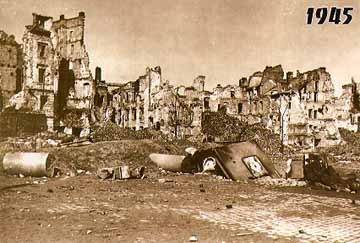 Area behind Statue
after Warsaw was destroyed
Area behind Statue
after Warsaw was destroyed
The monument is located in plac Zamkowy,
a large market square that is now filled with restaurant tables
with umbrellas advertising Frito Lay. The old photo above shows
what this square looked like after the destruction by the Germans
in World War II. Almost 90% of Old Town Warsaw was demolished
and the reconstruction project lasted from 1949 to 1963. The
Royal Palace is in the plaza to the east of where the column
stands; it was surrounded by scaffolding while reconstruction
was still going on when I was there in September 1998. Most of
the damage to The Royal Castle was inflicted by dynamite and
occured in the course of the systematic actions after the Warsaw
Uprising in 1944; rebuilding did not begin until 1971.
The photo below shows the reconstructed
buildings in the town square. The most significant damage to
the Old Market Square occured during the Warsaw Uprising of 1944
and in systematic relatiatory actions after it. In the photo, two boy scouts are walking across
the square in front of a horse and wagon waiting to take tourists
on a ride around New Town warsaw.
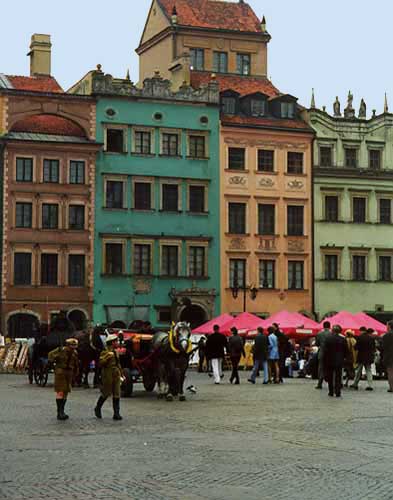 Reconstructed Town
square in Old Town Warsaw
Reconstructed Town
square in Old Town Warsaw
The beautiful buildings which surround
the Rynek, or town square, of Old Town Warsaw were once the mansions
of rich merchants. The middle of the square is now filled with
restaurant tables topped by colorful umbrellas with advertising
written on them. Several horse drawn carriages are lined up like
taxi cabs waiting for tourists. The drivers look like farmers
who are trying to make a little extra money on weekends.
I visited the Old Town on my first day
in Poland, and was not yet used to the fact that one American
dollar was more than 3 Polish zlotys, so when a carriage driver
told me that a ride was 60 zloty, I immediately protested that
it was too much. He lowered the price to 50 zlotys and we were
off on a tour around New Town. The driver could speak just enough
English to point out some of the sights, including the Monument
to the Heroes of Warsaw. At the end of World War II, the number
of casualties in the city was over 700,000 and the devastation
resembled that in Dresden. Later, on another tour, I saw the
Monument to the Heroes of the Ghetto on Zamenhofa street in the
Muranow district, where the Jewish Ghetto used to be.
Pictured above is a view of the reconstructed
houses that surround the Old Town square, with the carriages
waiting for customers. Only two of the mansions on the square,
numbers 34 and 35, survived the war-time destruction.
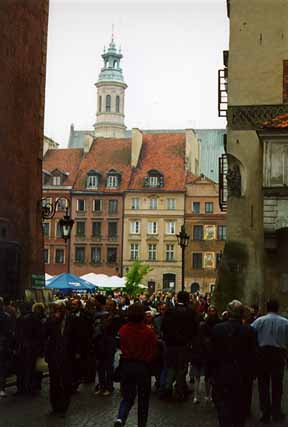 Entrance to Old Town
from New Town Warsaw
Entrance to Old Town
from New Town Warsaw
The photo above, taken in September 1998,
shows the Old Town market square as a crowd of people enter it
from a side street in New Town Warsaw. The old photo below shows
the same view as it looked in 1945 after Warsaw was destroyed
in World War II.
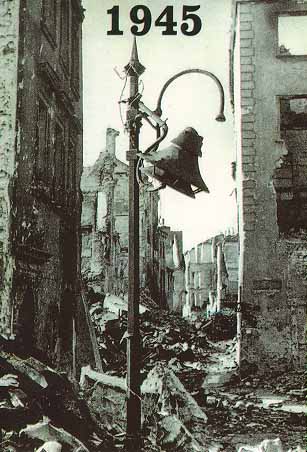 Entrance to Old Town
square after it was damaged
Entrance to Old Town
square after it was damaged
The following comments about the Warsaw
Uprising of 1944, taken from the web site http://www.warsawuprising.com,
was sent to me by Dariuz Tarkowski:
Some recent publications, like "Rising
'44" by Norman Davies, call the uprising a pivotal event
in the history of West-Soviet relations and the beginning of
the Cold War, because it was the first major event where Stalin
defiantly refused adequate military aid to fighters officially
recognized as an integral part of the Allied Coalition, backed
by Britain and the United States. It was also a major event in
the history of Poland, taking 200,000 civilian lives, 700,000
expelled from the city, 55,000 sent to concentration camps, including
13,000 to Auschwitz, and taking 15,000 lives of the Polish Home
Army soldiers (loyal the the Polish government-in-exile based
in London), 5,000 wounded, 15,000 sent to POW camps. Material
losses included 10,455 buildings, 923 historical buildings (94
percent) and most of the monuments.
The Warsaw Ghetto Uprising of 1943,
a separate event from the Warsaw Uprising of 1944, was started
by Jewish fighters in response the German efforts to liquidate
the ghetto, where about 55,000 people remained. There were two
major Jewish resistance groups, Jewish Fighting Organization
(ZOB) with 500 fighters and the Jewish Fighting Union (ZZW) with
200 fighers. Knowing that the Nazis had destined them to death,
these people decided to die fighting.
[....]
In the course of the 1944 uprising,
the Goose Farm concentration camp in Warsaw was liberated and
its Jewish inmates joined the Polish insurgents. Also, some Jewish
fighters from the 1943 uprising fought in the 1944 uprising.
This page was last updated on March 11,
2009
|